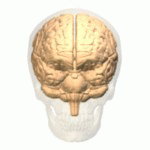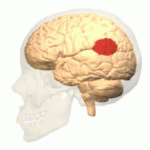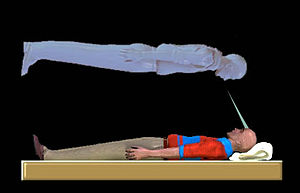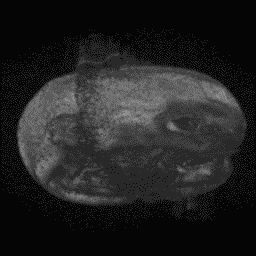User:Luckykarmz/sandbox



The temporoparietal junction (TPJ) is an area of the brain where the temporal and parietal lobes meet, at the posterior end of the Sylvian fissure. This area is known to play a crucial role in self-other distinction processes and theory of mind (ToM),[1] and damage to this area has been implicated in producing out-of-body experiences (OBEs).[2] OBEs may also be induced by electrically stimulating the TPJ. Electromagnetic disruptions of the TPJ have been shown to affect individuals' abilities to make moral decisions.[3]
Involvement in Out-of-Body Experiences
The TPJ is also a crucial structure for self-processing.[4] Several neuro-imaging studies have show an activation of the TPJ during different aspects of self-processing such as visuo-spatial perspective, self-other distinction, mental own body imagery, and vestibular and multi sensory integration.[5] Damage in the TPJ has been linked to out-of-body experiences (OBE), the feeling that one’s self is located outside one’s physical body.[6]
An OBE is defined by the presence of three characteristics: disembodiment, the impression of seeing the world from a distant and elevated visuo-spatial perspective, and the impression of seeing one’s own body from this elevated perspective.[7] OBEs mostly occur to people with epilepsy or migraines, but approximately 10% of the healthy population also experience OBEs once or twice in a lifetime.[8] They usually occur spontaneously and are of short duration, making OBEs hard to study. Here is an example of a patient describing what he or she experienced during an OBE:
“I was in bed and about to fall asleep when I had the distinct impression that “I” was at the ceiling level looking down at my body in the bed. I was very startled and frightened; immediately [afterward] I felt that, I was consciously back in the bed again.”[9]
A review in The Neuroscientist suggests that OBEs are caused by multi-sensory disintegration in the TPJ disrupting different aspects of self-processing such as illusory reduplication, illusory self-location, and illusory perspective.[10] The brain integrates different sensory inputs to create a representation of one’s body and its location in its surrounding. Some inhibition of discrepant inputs is required to have coherency, but in some cases, those discrepant inputs are so strong and come from more than one sensory source that it leads to two different representations of one’s own body.[11] This multi-sensory disintegration at the TPJ leads to OBEs. Evidence linking OBEs to the TPJ is presented in an experiment conducted by Dr. Olaf Blanke, an expert on OBEs, that is described in a review in The Journal of Neuroscience. An electromagnetic stimulation to the right TPJ of an patient with epilepsy epilepsy induced an OBE.[12] The author also states that these experiences are closely related to schizophrenia and phantom limb.
See also
Heading text
Heading text
- Indented line
- Bulleted list item
- Numbered list item
Temporoparietal junction on Wikipeida

References
- ^ Rebecca Saxe, Nancy Kanwisher (2003). "People thinking about thinking people: The role of the temporo-parietal junction in "theory of mind"". NeuroImage. 19 (4): 1835–1842. doi:10.1016/S1053-8119(03)00230-1. PMID 12948738. S2CID 206118958.
- ^ Olaf Blanke and Shahar Arzy (2005). "The Out-of-Body Experience: Disturbed Self-Processing at the Temporo-Parietal Juncti". The Neuroscientist. 11 (1): 16–24. doi:10.1177/1073858404270885. PMID 15632275. S2CID 8172076.
- ^ "Morality is modified in the lab". BBC News. 2010-03-30.
- ^ Blanke, O.; Ortigue, S.; Landis, T.; Seeck, M. (2002 Sep 19). "Stimulating illusory own-body perceptions" (PDF). Nature. 419 (6904): 269–70. doi:10.1038/419269a. PMID 12239558. S2CID 4427138.
{{cite journal}}: Check date values in:|date=(help) - ^ Blanke, O (2012 Jul 18). "Multisensory brain mechanisms of bodily self-consciousness". Nature Reviews. Neuroscience. 13 (8): 556–71. doi:10.1038/nrn3292. PMID 22805909. S2CID 15713909.
{{cite journal}}: Check date values in:|date=(help) - ^ Access: Brain electrodes conjure up ghostly visions: Nature News
- ^ Heydrich, L (2011 Mar). "Partial and full own-body illusions of epileptic origin in a child with right temporoparietal epilepsy". Epilepsy & Behavior : E&B. 20 (3): 583–6. doi:10.1016/j.yebeh.2011.01.008. PMID 21334265. S2CID 6234943.
{{cite journal}}: Check date values in:|date=(help); Unknown parameter|coauthors=ignored (|author=suggested) (help) - ^ Blanke, Olaf (January 2005). "Linking Out-of-Body Experience and Self Processing to Mental Own-Body Imagery at the Temporoparietal Junction". Journal of Neuroscience. 25 (3): 550–557. doi:10.1523/JNEUROSCI.2612-04.2005. PMC 6725328. PMID 15659590.
{{cite journal}}: Unknown parameter|coauthors=ignored (|author=suggested) (help)CS1 maint: date and year (link) - ^ Olaf Blanke and Shahar Arzy (2005). "The Out-of-Body Experience: Disturbed Self-Processing at the Temporo-Parietal Juncti". The Neuroscientist. 11 (1): 16–24. doi:10.1177/1073858404270885. PMID 15632275. S2CID 8172076.
- ^ Olaf Blanke and Shahar Arzy (2005). "The Out-of-Body Experience: Disturbed Self-Processing at the Temporo-Parietal Juncti". The Neuroscientist. 11 (1): 16–24. doi:10.1177/1073858404270885. PMID 15632275. S2CID 8172076.
- ^ Blanke, Olaf (January 2005). "Linking Out-of-Body Experience and Self Processing to Mental Own-Body Imagery at the Temporoparietal Junction". Journal of Neuroscience. 25 (3): 550–557. doi:10.1523/JNEUROSCI.2612-04.2005. PMC 6725328. PMID 15659590.
{{cite journal}}: Unknown parameter|coauthors=ignored (|author=suggested) (help)CS1 maint: date and year (link) - ^ Arzy, S.; Thut, G.; Mohr, C.; Michel, C. M.; Blanke, O. (2006 Aug 2). "Neural basis of embodiment: distinct contributions of temporoparietal junction and extrastriate body area". The Journal of Neuroscience : The Official Journal of the Society for Neuroscience. 26 (31): 8074–81. doi:10.1523/JNEUROSCI.0745-06.2006. PMC 6673771. PMID 16885221.
{{cite journal}}: Check date values in:|date=(help) - ^ Abu-Akel, A (2011 Sep). "Neuroanatomical and neurochemical bases of theory of mind". Neuropsychologia. 49 (11): 2971–84. doi:10.1016/j.neuropsychologia.2011.07.012. PMID 21803062. S2CID 36226051.
{{cite journal}}: Check date values in:|date=(help); Unknown parameter|coauthors=ignored (|author=suggested) (help)